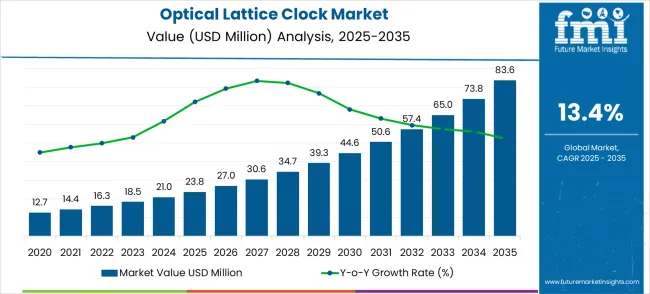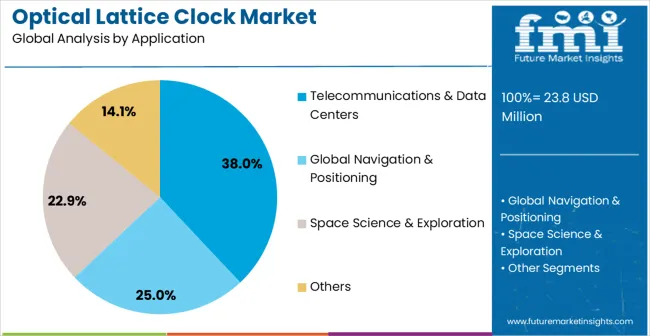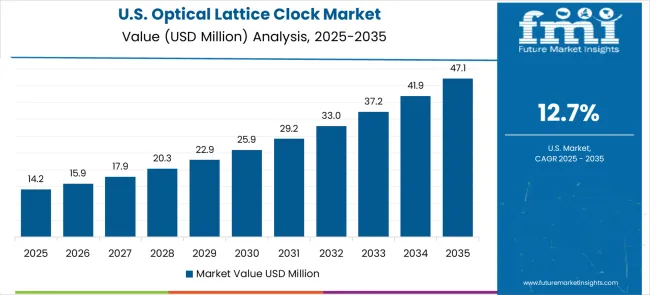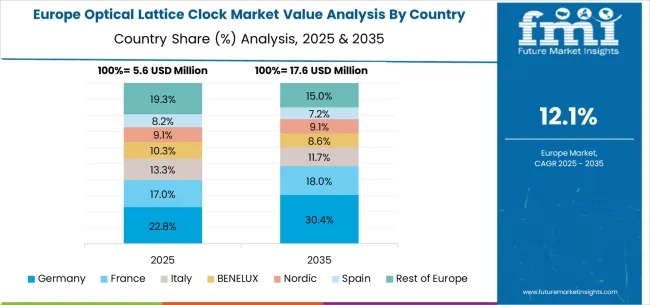The optical lattice clock market is valued at USD 23.8 million in 2025 and is expected to reach USD 83.6 million by 2035, advancing at a CAGR of 13.4%. From 2021 to 2025, the market experiences gradual growth, progressing from USD 12.7 million to USD 23.8 million. Annual increments reflect steady expansion through values of USD 14.4 million, 16.3 million, and 18.5 million. Growth is primarily driven by advancements in quantum technology and the increasing demand for ultra-precise timekeeping in sectors such as metrology, scientific research, and navigation. As the capabilities of optical lattice clocks evolve, they offer unparalleled precision, propelling market expansion.

Between 2026 and 2030, the market accelerates, moving from USD 23.8 million to USD 39.3 million, with intermediate values of USD 27.0 million, 30.6 million, and 34.7 million. This phase witnesses faster growth, fueled by expanding applications in space science, telecommunications, and emerging technologies where high-precision time measurements are critical. From 2031 to 2035, the market continues to rise, reaching USD 83.6 million, passing through USD 44.6 million, 50.6 million, 57.4 million, 65.0 million, and 73.8 million. The demand for optical lattice clocks increases with new commercial applications and ongoing technological innovations, highlighting strong and sustained growth in precision timekeeping across multiple industries.
| Metric | Value |
|---|---|
| Market Value (2025) | USD 23.8 million |
| Market Forecast Value (2035) | USD 83.6 million |
| Forecast CAGR (2025–2035) | 13.4% |
The optical lattice clock market is expected to experience substantial growth, with significant progress anticipated in the latter half of the forecast period. The market size is projected to see a notable increase over the coming years. The peak years will likely coincide with breakthroughs in precision timing technologies, driving adoption across sectors like telecommunications, navigation, and fundamental physics. The initial years may see slower growth, with gradual increases from USD 23.8 million in 2025 to USD 50.6 million in 2030, as the market overcomes high R&D costs and technical challenges.
Segment-wise, YoY growth will vary, with strong demand driven by research and government-led initiatives. Consumer and industrial sectors may face slower adoption due to the complexity and cost of the technology. Regionally, North America and Europe are expected to lead the market, with North America projected to contribute significantly to the overall growth, pushing market values from USD 23.8 million in 2025 to USD 50.6 million in 2030. Asia-Pacific is poised to experience significant growth in the later years, particularly in China and Japan, with market values increasing sharply from USD 23.8 million in 2025 to USD 83.6 million by 2035.
Market expansion is being supported by the rapidly advancing quantum technology sector and the corresponding need for ultra-precise timing systems that enable breakthrough applications in telecommunications, navigation, and fundamental physics research. Modern quantum applications require exceptional timing accuracy that far exceeds conventional atomic clock capabilities, driving demand for optical lattice clocks that provide unprecedented precision and stability. The revolutionary timing precision and stability characteristics of optical lattice clocks make them essential components in cutting-edge applications where femtosecond-level accuracy and long-term frequency stability are paramount.
The growing focus on quantum technology development and next-generation communication systems is driving demand for advanced timing technologies from specialized manufacturers with proven expertise in quantum optics and precision metrology. Research institutions and technology companies are increasingly investing in optical lattice clock systems that offer transformational timing capabilities for quantum computing, quantum communication, and advanced navigation applications. Scientific requirements and technological advancement needs are establishing performance benchmarks that favor ultra-precise optical timing solutions with demonstrated quantum-level accuracy and stability.
The market is segmented by clock type, application, and region. By system configuration, the market is divided into lab-grade optical lattice clocks, transportable/fieldable optical lattice clocks, space-qualified optical lattice clocks, and other specialized configurations. Based on application, the market is categorized into telecommunications & data centers, global navigation & positioning, space science & exploration, and other advanced applications. Regionally, the market is divided into North America, Europe, East Asia, South Asia & Pacific, Latin America, and Middle East & Africa.

The lab-grade optical lattice clocks segment is projected to account for 52% of the optical lattice clock market in 2025. This leading share is driven by the high-precision timing systems required for quantum physics research, metrology, and quantum technology development. Lab-grade systems provide exceptional timing accuracy and flexibility, making them ideal for fundamental physics experiments, metrology institutes, and next-gen quantum technologies. Innovations such as ultra-stable laser sources, laser cooling systems, and environmental isolation have pushed the precision to the 10^-19 level, enabling groundbreaking measurements and experiments like tests of general relativity and dark matter detection. Government funding for quantum research is further fueling demand for these clocks, which are central to advancing scientific knowledge and developing future quantum technologies.

The telecommunications & data centers segment is expected to represent 38% of optical lattice clock demand in 2025, highlighting its importance in supporting next-gen communication networks like 5G, 6G, and quantum communications. These applications require ultra-precise timing for synchronization across distributed networks, data centers, and emerging quantum communication systems. With substantial global investment in advanced communication infrastructure, the need for femtosecond-level synchronization and long-term frequency stability has become essential for critical communication systems. The growth of 5G/6G networks and the shift towards quantum communication technologies are major drivers of demand. The development of the quantum internet and distributed quantum computing further expands opportunities for optical lattice clocks in telecom, offering synchronization capabilities for quantum entanglement and quantum algorithms.
The optical lattice clock market is advancing rapidly due to breakthrough developments in quantum technology and growing recognition of ultra-precise timing importance in next-generation applications. The market faces challenges including extremely high development and manufacturing costs, complex technical requirements demanding specialized expertise, and limited availability of qualified technical personnel. Continued research funding and technical advancement programs are essential for translating laboratory achievements into practical commercial applications.
The growing development of integrated quantum systems and miniaturized optical components is enabling more practical implementations of optical lattice clocks for field applications and commercial deployment. Advanced integration technologies provide reduced system complexity and improved reliability while maintaining ultra-high precision timing capabilities. These technologies are particularly important for developing transportable and space-qualified optical clocks that can operate outside controlled laboratory environments.
Modern optical clock manufacturers are incorporating ruggedized designs and automated operation capabilities that enable deployment in commercial and space applications while maintaining laboratory-level precision. Integration of advanced stabilization systems and environmental compensation technologies enables unprecedented timing accuracy in challenging operational environments and significant performance advantages compared to conventional atomic timing systems. Advanced engineering and manufacturing approaches also support development of cost-effective optical clock solutions for emerging commercial applications requiring extreme timing precision.

| Country | CAGR (2025–2035) |
|---|---|
| China | 18.1% |
| India | 16.8% |
| Germany | 15.4% |
| Brazil | 14.1% |
| United States | 12.7% |
| United Kingdom | 11.4% |
| Japan | 10.1% |
The optical lattice clock market is growing rapidly, with China leading at an 18.1% CAGR through 2035, driven by massive quantum technology investment, national quantum research programs.India follows at 16.8%, supported by expanding quantum research initiatives and growing investments in advanced metrology and precision timing technologies. Germany records strong growth at 15.4%, emphasizing quantum technology leadership, precision physics research, and advanced manufacturing capabilities in quantum systems. Brazil grows steadily at 14.1%, developing quantum research capabilities and investing in advanced timing technologies for telecommunications and navigation applications. The United States shows robust growth at 12.7%, focusing on quantum technology leadership and defense applications requiring ultra-precise timing systems. The United Kingdom maintains strong expansion at 11.4%, supported by quantum research excellence and advanced technology development programs. Japan demonstrates significant growth at 10.1%, emphasizing precision technology innovation and quantum system development.
The report covers an in-depth analysis of 40+ countries with top-performing countries highlighted below.
China is expected to lead the optical lattice clock market with a CAGR of 18.1% from 2025 to 2035. The country's rapid advancements in quantum computing and metrology technologies are driving demand for high-precision timekeeping systems. China’s strong focus on scientific innovation, particularly in space exploration and telecommunications, is a key factor contributing to the market growth. The government's increased investment in quantum research and the growing importance of high-accuracy atomic clocks in satellite-based communication and GPS systems further fuel demand. Involvement in global space programs and its own space missions require optical lattice clocks for time synchronization in satellite and ground systems. The research institutions and universities are making substantial progress in the development of cutting-edge quantum technologies, which are expected to increase the adoption of optical lattice clocks across the country.
The optical lattice clock market in India is projected to grow at a CAGR of 16.8% from 2025 to 2035. The country’s increasing interest in quantum technologies and high-precision measurement systems is contributing to this rapid market expansion. India’s space missions, including satellite launches and interplanetary exploration, require accurate timekeeping systems to support the navigation and synchronization of spacecraft. Optical lattice clocks play a critical role in enhancing the precision of satellite communication systems. Moreover, India’s growing telecommunications industry and demand for ultra-precise time synchronization are boosting the market for optical lattice clocks. With a significant focus on advancing scientific research and establishing leadership in space exploration, the country is poised to see continued growth in the demand for optical lattice clocks. The Indian government’s funding and support for the development of quantum technologies will likely further accelerate the market.
The optical lattice clock market in Germany is expected to grow at a CAGR of 15.4% between 2025 and 2035. Germany has a long history of leadership in scientific research, particularly in atomic physics and quantum metrology. The demand for optical lattice clocks is being driven by the country’s continued advancement in quantum research, space technologies, and telecommunications. The space agency, DLR, is investing in advanced timekeeping systems to support satellite missions, while optical lattice clocks are essential for achieving ultra-precise measurements in scientific experiments. The country’s focus on improving the accuracy of GPS and satellite communication systems is further boosting market growth. Commitment to expanding its technological infrastructure in both commercial and industrial sectors, including precision manufacturing, contributes to the rising demand for high-precision timekeeping systems.
The optical lattice clock market in Brazil is set to grow at a CAGR of 14.1% from 2025 to 2035. The country’s burgeoning space program, including its collaboration with international agencies, is a key driver of the market. Brazil’s national space initiatives, such as satellite navigation systems and space exploration projects, are creating significant demand for high-precision timekeeping solutions like optical lattice clocks. As Brazil continues to expand its aerospace and telecommunications industries, the need for accurate synchronization in satellite communications will grow. The increasing focus on precision timing in the industrial and scientific sectors is fostering demand for advanced atomic clocks. The government’s push to improve research infrastructure and collaboration with global partners will likely accelerate the adoption of these clocks across various high-tech sectors. Brazil’s expanding scientific research and focus on precision measurement in agriculture and meteorology will also boost the market.

The United States is projected to see steady growth in the optical lattice clock market, with a CAGR of 12.7% from 2025 to 2035. The USA is a leader in the development and application of quantum technologies, and optical lattice clocks are essential in areas like space exploration, telecommunications, and military applications. The space agency, NASA, along with its military branches, requires precise timekeeping for satellite systems, GPS, and inter-satellite communication. Optical lattice clocks play a critical role in national security and defense systems, where accurate timing is vital for operations. As the USA continues to innovate in quantum computing and quantum communication technologies, the demand for high-precision clocks will increase. The commercial sector, including industries like telecommunications and aerospace, will also drive demand, particularly for advanced synchronization and measurement solutions.
The United Kingdom’s optical lattice clock market is expected to grow at a CAGR of 11.4% from 2025 to 2035. The UK has been a strong proponent of quantum technologies, and optical lattice clocks play an integral role in the country's scientific research initiatives. The demand for these clocks is largely driven by space research, satellite communication, and precise time synchronization in telecommunication networks. The UK’s space agency, along with private sector ventures, is increasingly relying on optical lattice clocks for satellite navigation and deep space exploration projects. As the country expands its commitment to next-generation quantum technology, optical lattice clocks are set to become even more integral to scientific and industrial applications. With the growing focus on high-precision measurements in scientific experiments and national infrastructure, the market for optical lattice clocks in the UK is set for steady growth.

The optical lattice clock market in Japan is projected to expand at a CAGR of 10.1% from 2025 to 2035. As a leader in technological innovation, Japan's space agency, JAXA, and other scientific research institutions require precise timekeeping systems for their satellite missions and space exploration projects. The growing interest in quantum technologies, particularly for telecommunications and GPS systems, is boosting the demand for optical lattice clocks. Commitment to precision measurement systems for weather forecasting, agricultural monitoring, and scientific research applications also supports market growth. As Japan strengthens its position in the global space and quantum technology sectors, the demand for optical lattice clocks will increase, especially in areas requiring ultra-high accuracy and synchronization.

The optical lattice clock market in Europe is projected to grow from USD 5.6 million in 2025 to USD 17.6 million by 2035, registering a CAGR of 12.1% over the forecast period. Germany will dominate, expanding from 22.8% in 2025 to 30.4% by 2035, supported by its quantum research leadership, precision physics infrastructure, and timing technology innovation programs. France will account for 17.0% in 2025, increasing to 18.0% by 2035, reflecting growing investments in quantum technology and precision measurement applications. Italy is projected to hold 13.3% in 2025, declining slightly to 11.7% by 2035, reflecting steady but maturing demand in physics research applications.
The BENELUX region will capture 10.3% in 2025, softening to 8.6% by 2035, reflecting consolidation of specialized timing research centers. The Nordic countries will hold 9.1% in 2025, remaining stable at 9.1% by 2035, supported by advanced precision optics and quantum research institutions. Spain will contribute 8.2% in 2025, holding nearly steady at 8.7% by 2035, reflecting consistent adoption in academic and applied quantum timing projects. Meanwhile, the Rest of Europe will decline from 19.3% in 2025 to 15.0% by 2035, as quantum technology investment remains concentrated in Western Europe.

The optical lattice clock market is defined by competition among specialized quantum technology companies, precision instrumentation manufacturers, and advanced research equipment suppliers. Companies are investing in breakthrough quantum technologies, ultra-precise laser systems, advanced control software, and comprehensive research support services to deliver revolutionary timing solutions with unprecedented precision capabilities. Strategic research partnerships, technology innovation, and scientific collaboration are central to strengthening technological capabilities and market presence.
Shimadzu Corporation, operating globally, offers comprehensive precision measurement solutions with focus on advanced analytical instrumentation and quantum technology applications. M Squared Lasers provides specialized laser systems with focus on quantum technology applications and ultra-stable laser sources for optical clock systems. Muquans delivers innovative quantum sensing and timing solutions with focus on portable and fieldable quantum technologies. Menlo Systems offers advanced optical frequency measurement systems with proven precision timing and spectroscopy applications.
The optical lattice clock market underpins quantum technology advancement, precision metrology excellence, fundamental physics research, and next-generation communication systems. With quantum technology investment, scientific research requirements, and demand for unprecedented timing precision, the sector must balance technological innovation, scientific rigor, and practical application development. Coordinated contributions from governments, research institutions, manufacturers, technology companies, and investors will accelerate the transition toward practical, reliable, and commercially viable optical lattice clock technologies.
| Items | Values |
|---|---|
| Quantitative Units | USD 23.8 million |
| Classification Type | Lab-Grade Optical Lattice Clocks, Transportable / Fieldable Optical Lattice Clocks, Space-Qualified Optical Lattice Clocks, Others |
| Application | Telecommunications & Data Centers, Global Navigation & Positioning, Space Science & Exploration, Others |
| Regions Covered | North America, Europe, East Asia, South Asia & Pacific, Latin America, Middle East & Africa |
| Country Covered | United States, Germany, India, China, United Kingdom, Japan, Brazil, and other 40+ countries |
| Key Companies Profiled | Shimadzu Corporation, M Squared Lasers, Muquans, Menlo Systems |
| Additional Attributes | Dollar sales by clock type and application, regional demand trends across North America, Europe, and Asia-Pacific, competitive landscape with specialized quantum technology manufacturers and research equipment suppliers, buyer preferences for different optical lattice clock configurations and precision requirements, integration with advanced quantum technologies and precision measurement systems, innovations in laser cooling and optical trapping for enhanced clock stability and accuracy, and adoption of transportable and space-qualified optical lattice clock solutions with ruggedized design and automated operation capabilities for field applications and space missions. |
The global optical lattice clock market is estimated to be valued at USD 23.8 million in 2025.
The market size for the optical lattice clock market is projected to reach USD 83.6 million by 2035.
The optical lattice clock market is expected to grow at a 13.4% CAGR between 2025 and 2035.
The key product types in optical lattice clock market are lab-grade optical lattice clocks, transportable / fieldable optical lattice clocks and space-qualified optical lattice clocks.
In terms of application, telecommunications & data centers segment to command 38.0% share in the optical lattice clock market in 2025.






Our Research Products

The "Full Research Suite" delivers actionable market intel, deep dives on markets or technologies, so clients act faster, cut risk, and unlock growth.

The Leaderboard benchmarks and ranks top vendors, classifying them as Established Leaders, Leading Challengers, or Disruptors & Challengers.

Locates where complements amplify value and substitutes erode it, forecasting net impact by horizon

We deliver granular, decision-grade intel: market sizing, 5-year forecasts, pricing, adoption, usage, revenue, and operational KPIs—plus competitor tracking, regulation, and value chains—across 60 countries broadly.

Spot the shifts before they hit your P&L. We track inflection points, adoption curves, pricing moves, and ecosystem plays to show where demand is heading, why it is changing, and what to do next across high-growth markets and disruptive tech

Real-time reads of user behavior. We track shifting priorities, perceptions of today’s and next-gen services, and provider experience, then pace how fast tech moves from trial to adoption, blending buyer, consumer, and channel inputs with social signals (#WhySwitch, #UX).

Partner with our analyst team to build a custom report designed around your business priorities. From analysing market trends to assessing competitors or crafting bespoke datasets, we tailor insights to your needs.
Supplier Intelligence
Discovery & Profiling
Capacity & Footprint
Performance & Risk
Compliance & Governance
Commercial Readiness
Who Supplies Whom
Scorecards & Shortlists
Playbooks & Docs
Category Intelligence
Definition & Scope
Demand & Use Cases
Cost Drivers
Market Structure
Supply Chain Map
Trade & Policy
Operating Norms
Deliverables
Buyer Intelligence
Account Basics
Spend & Scope
Procurement Model
Vendor Requirements
Terms & Policies
Entry Strategy
Pain Points & Triggers
Outputs
Pricing Analysis
Benchmarks
Trends
Should-Cost
Indexation
Landed Cost
Commercial Terms
Deliverables
Brand Analysis
Positioning & Value Prop
Share & Presence
Customer Evidence
Go-to-Market
Digital & Reputation
Compliance & Trust
KPIs & Gaps
Outputs
Full Research Suite comprises of:
Market outlook & trends analysis
Interviews & case studies
Strategic recommendations
Vendor profiles & capabilities analysis
5-year forecasts
8 regions and 60+ country-level data splits
Market segment data splits
12 months of continuous data updates
DELIVERED AS:
PDF EXCEL ONLINE
Strontium Optical Lattice Clock Market Size and Share Forecast Outlook 2025 to 2035
Optical Spectrum Analyzer Market Size and Share Forecast Outlook 2025 to 2035
Optical Extinction Analyzer Market Size and Share Forecast Outlook 2025 to 2035
Optical Character Recognition Market Forecast and Outlook 2025 to 2035
Optical Satellite Market Size and Share Forecast Outlook 2025 to 2035
Optical Imaging Market Size and Share Forecast Outlook 2025 to 2035
Optical Whitening Agents Market Size and Share Forecast Outlook 2025 to 2035
Optical Fingerprint Collector Market Size and Share Forecast Outlook 2025 to 2035
Optical Lens Materials Market Size and Share Forecast Outlook 2025 to 2035
Optical Microscope Market Size and Share Forecast Outlook 2025 to 2035
Optical Component Tester Market Size and Share Forecast Outlook 2025 to 2035
Optical EMI Shielding Adapters Market Size and Share Forecast Outlook 2025 to 2035
Optical Connector Polishing Films Market Size and Share Forecast Outlook 2025 to 2035
Optical Transmitter Market Size and Share Forecast Outlook 2025 to 2035
Optical Telephoto Lens Market Size and Share Forecast Outlook 2025 to 2035
Optical Grade Lithium Tantalate Wafers Market Size and Share Forecast Outlook 2025 to 2035
Optical Grade LiTaO3 Crystal Substrate Market Size and Share Forecast Outlook 2025 to 2035
Optical Brighteners Market Size and Share Forecast Outlook 2025 to 2035
Optical Liquid Level Sensor Market Size and Share Forecast Outlook 2025 to 2035
Optical Fiber Market Size and Share Forecast Outlook 2025 to 2035

Thank you!
You will receive an email from our Business Development Manager. Please be sure to check your SPAM/JUNK folder too.
Chat With
MaRIA